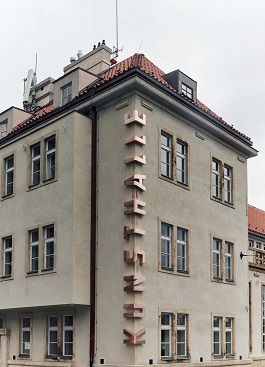
The transformer station has been transformed into Kunsthalle Prague, which will open on Tuesday
 |
"We wanted to create a friendly and creative place that inspires through art, one that is here for those who love art, as well as for those who are still finding their way to art," Ivana Goosen, the executive director of the Pudil Family Foundation, told journalists today. She explained why the organizers chose the name Kunsthalle.
"This term is now a common designation for a type of institution anywhere in the world. Unlike museums, which were created to care for collections, kunsthalle was established for temporary exhibitions," she stated. According to her, these models are now converging, but the concept of rotating exhibitions inspired the naming of Kunsthalle Prague. "It also reflects our focus, our goal, to connect the Czech and international scenes," she added.
Kunsthalle Prague has its collection and focuses on art from the early 20th century to the present, but it will not exhibit it permanently. Several works are featured in the exhibition on kineticism, and more will be displayed occasionally. It will be presented online, with approximately 300 works currently accessible, with plans to increase that number, according to the director. The kunsthalle's program will include six to eight exhibitions a year, including educational programs and workshops. "Because the kunsthalle is located in a former transformer station building, we are interested in connecting art, science, and technology," she said.
"For me and (my wife) Pavlína, this is a very special moment. The journey has taken some time, and today we are at such a turning point where it is not the end of something, but rather the beginning of something wonderful," Pudil told journalists. "Art and institutions are a great way to bridge divides in society, to inspire people, to bring perspectives from our predecessors or their contemporaries into the lives of the young. That was perhaps the main motivation we wanted to achieve with this act, that is, the establishment of the Kunsthalle Prague foundation and the reconstruction of this building," he stated.
The exhibition Kineticism: 100 Years of Electricity in Art captures the development of art from the first artistic uses of motorized movement and artificial light to information technologies and contemporary digital art. Its four key areas are cinematography, kinetic art, cybernetic art, and computer art. The exhibition showcases about a hundred works, including loans from significant institutions like the British Tate Gallery or the French Centre Pompidou. It will present works by pioneers such as Mary Ellen Bute, László Moholy-Nagy, Marcel Duchamp, and Zdeněk Pešánek.
Since its construction, the former Zenger transformer station building has been directly and closely associated with Pešánek. For its façade, a set of allegorical luminokinetic sculptures titled One Hundred Years of Electricity was designed between 1932 and 1936. The exhibition directly follows this legacy, revealing the connection between moving machines and moving images: electricity.
The preparation of Kunsthalle took seven years, but it faced protests from several artists even before its opening. Kunsthalle was built by the Pudil Family Foundation, which Pudil established with his wife. They contributed their art collection to the foundation's assets, creating the Kunsthalle Prague foundation fund. Three years ago, during a public presentation of Pudil's foundation, about thirty artists organized a protest, claiming that Pudil was, in their view, laundering his money through art, labeling such actions as artwashing.
In 2005, Pudil participated in the purchase of the Mostecká coal company from the Appian Group, which he integrated into the newly formed Czech Coal group. In 2010, he sold his share to Pavel Tykač's companies. According to publicly available sources, Pudil did not participate in the privatization of the Mostecká coal company and has not been tried in any of the processes related to the privatization.
The English translation is powered by AI tool. Switch to Czech to view the original text source.
Related articles
0
21.02.2023 | Last year, the Kunsthalle Prague gallery was opened
0
25.01.2022 | In February, Kunsthalle Prague will open, a new gallery space
0
10.09.2019 | Kunsthalle Prague will manage the years-in-the-making collection of the Zemans
0
06.05.2019 | Kunsthalle Prague will open in two years, and is already preparing the program
0
30.09.2017 | Projection on the façade of the transformer station at Klárov will bring its history closer











